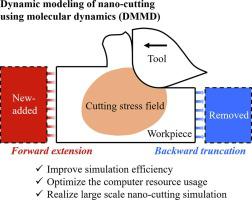当前位置:
X-MOL 学术
›
Comp. Mater. Sci.
›
论文详情
Our official English website, www.x-mol.net, welcomes your
feedback! (Note: you will need to create a separate account there.)
Study on nano-cutting of brittle material by molecular dynamics using dynamic modeling
Computational Materials Science ( IF 3.1 ) Pub Date : 2020-10-01 , DOI: 10.1016/j.commatsci.2020.109851 Jinshi Wang , Xiaodong Zhang , Fengzhou Fang , Feifei Xu , Rongtai Chen , Zhifu Xue
Computational Materials Science ( IF 3.1 ) Pub Date : 2020-10-01 , DOI: 10.1016/j.commatsci.2020.109851 Jinshi Wang , Xiaodong Zhang , Fengzhou Fang , Feifei Xu , Rongtai Chen , Zhifu Xue

|
Abstract Nano-cutting of brittle material finds wide applications in scientific research and engineering. Numerical simulation is an important tool for understanding the process mechanism, which has many advantages over experimental approaches. Currently, molecular dynamics is the most used method for nano-cutting simulation owing to its explicit description of material at atomic level. However, the model scale in current studies is far smaller than the reality. As a result, cutting-induced fracture, the main surface damage in the machining of brittle material, is difficult to reveal and well understand, which has become a critical issue in the field. In this study, a novel simulation approach is proposed to improve the computing efficiency after analyzing the shortcomings of traditional model. The principle is to build a localized workpiece near the tool which is dynamically modified so that the length of workpiece in computation is reduced and the saved computer resource can be used to increase the depth of cut and the tool edge radius. A large scale simulation on germanium verifies the capability of this method and reveals the fracture damage formation during the cutting process.
中文翻译:

基于动态建模的分子动力学纳米切削脆性材料研究
摘要 脆性材料的纳米切割在科学研究和工程中有着广泛的应用。数值模拟是理解过程机制的重要工具,与实验方法相比具有许多优势。目前,分子动力学是最常用的纳米切割模拟方法,因为它在原子水平上对材料进行了明确的描述。然而,目前研究中的模型规模远小于现实。因此,切削断裂是脆性材料加工中的主要表面损伤,难以揭示和理解,已成为该领域的关键问题。本研究在分析了传统模型的缺点后,提出了一种新的仿真方法来提高计算效率。其原理是在刀具附近建立一个局部化的工件,并动态修改,从而减少工件的计算长度,节省的计算机资源可用于增加切削深度和刀具边缘半径。对锗的大规模模拟验证了该方法的能力,并揭示了切割过程中的断裂损伤形成。
更新日期:2020-10-01
中文翻译:

基于动态建模的分子动力学纳米切削脆性材料研究
摘要 脆性材料的纳米切割在科学研究和工程中有着广泛的应用。数值模拟是理解过程机制的重要工具,与实验方法相比具有许多优势。目前,分子动力学是最常用的纳米切割模拟方法,因为它在原子水平上对材料进行了明确的描述。然而,目前研究中的模型规模远小于现实。因此,切削断裂是脆性材料加工中的主要表面损伤,难以揭示和理解,已成为该领域的关键问题。本研究在分析了传统模型的缺点后,提出了一种新的仿真方法来提高计算效率。其原理是在刀具附近建立一个局部化的工件,并动态修改,从而减少工件的计算长度,节省的计算机资源可用于增加切削深度和刀具边缘半径。对锗的大规模模拟验证了该方法的能力,并揭示了切割过程中的断裂损伤形成。











































 京公网安备 11010802027423号
京公网安备 11010802027423号